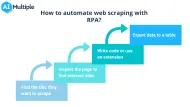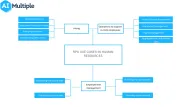In-Depth Guide to Attended vs Unattended RPA in 2024
RPA is one of the major players in the digital transformation space, as it enables the automation of repetitive, time-consuming tasks. But there are different types of RPA bots that differ from each other in terms of programmability and human usage.
For instance, attended RPA bots need a human in the loop. Unattended bots, on the other hand, are more autonomous. Finally, there are hybrid RPA bots that need a little “push” from humans at first but can execute a task automatically from thereafter.
It is important to know the differences between the attended vs unattended RPA to automate your processes efficiently.
In this article, we will explore the differences between attended and unattended automation RPA. We will also discuss what an hybrid RPA is. By the end, we hope to have assisted you in choosing the right RPA tool for your business and automation needs.
What is attended automation?
Attended automation (also called Robotic Desktop Automation) are bots that reside on the user’s machine and are invoked by them. They are appropriate for tasks that are triggered at programmatically hard-to-detect points along a process.
For example, to complete a transaction, a customer service rep might have to work with 3 separate application windows and complete manual steps. Instead of doing those, the rep can launch the attended automation code. The RPA bot would exactly replicate the rep’s steps, as if they been doing it manually. And if the bot encounters an exception, it can inform the rep to intervene.
Attended automation can be used as a digital worker to augment your workforce that has to rely on manual work to complete the tasks.
What is unattended automation?
Unattended bots are like batch processes on the cloud. They complete data processing tasks in the background. They are ideal for reducing work of back-office employees.
Unattended automation is usually optimal for processes that need permissions to be processed. This might sound counter-intuitive: how can unattended automation bypass a security that needs human authentication?
Users can give RPA bots permission to automatically log into a system with their login credentials on predetermined intervals to carry out a task. Moreover, because the bots’ activity on the system is recorded, it leaves an audit trail for users to monitor to ensure that no one else, except the bot, has used their login credentials to get into the system.
What is the difference between attended vs unattended RPA?
The main difference between attended vs unattended RPA is that:
- Attended RPA needs a human to be involved in the execution of a process,
- Unattended RPA can be programmed to be launch and execute a process autonomously
Generally, it’s best to leverage:
- Attended automation for tasks that need human input at some stage of their workflow.
- Unattended automation for every other process.
What are the 4 different ways of launching an unattended bot?
1. Data input in a specified location
Most unattended bots are triggered when data is input in the system. For instance, whenever a new transaction is identified, the bot is “triggered” and would automatically carry out its actions.
In revenue reconciliation, for instance, the receivables from the client should match the sales invoice. Bots can be programmed to monitor the company’s bank account for new deposits, and to automatically cross check each one with unreconciled invoices to reconcile them.
2. Bot initiated
A bot can also launch another bot. This can be useful when a bot operation has various different outcomes. For example, a KYC inquiry may either require manual investigation, or automated processing, to complete the customer’s registration.
Based on the outcome of the initial inquiry, the bot can notify the investigation team, or launch another bot to complete registration.
3. Orchestrator initiated
RPA administrators can use an orchestrator software to manually stop or launch bots.
4. Specified intervals
Bots can be launched at specific times to batch-process the data. For instance, a restaurant might need weekly reports of its ingredients’ use on each Saturday. They can program the RPA bot to start generating these reports during a specific hour, every Saturday.
What is hybrid automation?
Attended and unattended RPA bots are combined to provide automation for both front office and back-office activities, allowing end-to-end automation of a process. This is called hybrid automation, or hybrid RPA.
For instance, a customer service RPA bot can fetch software data from the IT database to generate an email, answering a product troubleshooting inquiry. Once the email is sent, the RPA bot will then notify the employee in the loop (e.g., customer service rep, technical support team) to initiate a call with the customer to receive feedback on the email that was sent.
For more on RPA
To better choose your RPA tool, explore our comprehensive articles about RPA tools:
- The 5 RPA Programming Options You Need to Know
- What is Cognitive RPA: In-Depth Guide to RPA’s Future
- Best RPA Companies in terms of Funding & Popularity
And if you want to invest in an RPA solution, scroll through our data-driven list of RPA vendors, and other automation solutions.
And we can guide you through the process:
This article was drafted by former AIMultiple industry analyst Alamira Jouman Hajjar.

Cem has been the principal analyst at AIMultiple since 2017. AIMultiple informs hundreds of thousands of businesses (as per similarWeb) including 60% of Fortune 500 every month.
Cem's work has been cited by leading global publications including Business Insider, Forbes, Washington Post, global firms like Deloitte, HPE, NGOs like World Economic Forum and supranational organizations like European Commission. You can see more reputable companies and media that referenced AIMultiple.
Throughout his career, Cem served as a tech consultant, tech buyer and tech entrepreneur. He advised businesses on their enterprise software, automation, cloud, AI / ML and other technology related decisions at McKinsey & Company and Altman Solon for more than a decade. He also published a McKinsey report on digitalization.
He led technology strategy and procurement of a telco while reporting to the CEO. He has also led commercial growth of deep tech company Hypatos that reached a 7 digit annual recurring revenue and a 9 digit valuation from 0 within 2 years. Cem's work in Hypatos was covered by leading technology publications like TechCrunch and Business Insider.
Cem regularly speaks at international technology conferences. He graduated from Bogazici University as a computer engineer and holds an MBA from Columbia Business School.
To stay up-to-date on B2B tech & accelerate your enterprise:
Follow on

Comments
Your email address will not be published. All fields are required.